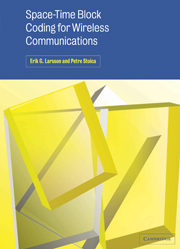Book contents
- Frontmatter
- Contents
- ABOUT THE AUTHORS
- PREFACE
- NOTATION
- COMMONLY USED SYMBOLS
- ABBREVIATIONS
- 1 INTRODUCTION
- 2 THE TIME-INVARIANT LINEAR MIMO CHANNEL
- 3 MIMO INFORMATION THEORY
- 4 ERROR PROBABILITY ANALYSIS
- 5 RECEIVE DIVERSITY
- 6 TRANSMIT DIVERSITY AND SPACE-TIME CODING
- 7 LINEAR STBC FOR FLAT FADING CHANNELS
- 8 LINEAR STBC FOR FREQUENCY-SELECTIVE CHANNELS
- 9 COHERENT AND NON-COHERENT RECEIVERS
- 10 SPACE-TIME CODING FOR INFORMED TRANSMITTERS
- 11 SPACE-TIME CODING IN A MULTIUSER ENVIRONMENT
- A SELECTED MATHEMATICAL BACKGROUND MATERIAL
- B THE THEORY OF AMICABLE ORTHOGONAL DESIGNS
- REFERENCES
- INDEX
6 - TRANSMIT DIVERSITY AND SPACE-TIME CODING
Published online by Cambridge University Press: 31 October 2009
- Frontmatter
- Contents
- ABOUT THE AUTHORS
- PREFACE
- NOTATION
- COMMONLY USED SYMBOLS
- ABBREVIATIONS
- 1 INTRODUCTION
- 2 THE TIME-INVARIANT LINEAR MIMO CHANNEL
- 3 MIMO INFORMATION THEORY
- 4 ERROR PROBABILITY ANALYSIS
- 5 RECEIVE DIVERSITY
- 6 TRANSMIT DIVERSITY AND SPACE-TIME CODING
- 7 LINEAR STBC FOR FLAT FADING CHANNELS
- 8 LINEAR STBC FOR FREQUENCY-SELECTIVE CHANNELS
- 9 COHERENT AND NON-COHERENT RECEIVERS
- 10 SPACE-TIME CODING FOR INFORMED TRANSMITTERS
- 11 SPACE-TIME CODING IN A MULTIUSER ENVIRONMENT
- A SELECTED MATHEMATICAL BACKGROUND MATERIAL
- B THE THEORY OF AMICABLE ORTHOGONAL DESIGNS
- REFERENCES
- INDEX
Summary
This chapter will take the first step towards exposing the reader to the concept of transmit diversity. We begin by studying a system where the channel is known to the transmitter. Next we assume that the channel is unknown at the transmitter site and show how transmit diversity can be achieved via repeated transmission of a single symbol, and how such transmit diversity is related to the receive diversity discussed in the previous chapter. Finally, we provide a more systematic discussion of space-time coding and also set the framework for the rest of this book. In most parts of this chapter, we assume a frequency flat channel (frequency selective channels will be discussed in Chapter 8).
Optimal Beamforming with Channel Known at Transmitter
As a preparation we shall begin by studying a system with nr ≥ 1 receive and nt > 1 transmit antennas, where both the transmitter and receiver know the propagation channel. This knowledge about the channel can be used to adapt the weights for each transmit antenna in such a way that the SNR at the receiver is maximized. Doing so is sometimes called “beamforming,” although it (like the beamforming in Section 5.1) may not have the physical interpretation of forming a beam. All the analysis presented in this section is straightforward; some of it can also be found in [ganesan and stoica, 2001b].
- Type
- Chapter
- Information
- Space-Time Block Coding for Wireless Communications , pp. 79 - 96Publisher: Cambridge University PressPrint publication year: 2003
- 1
- Cited by



